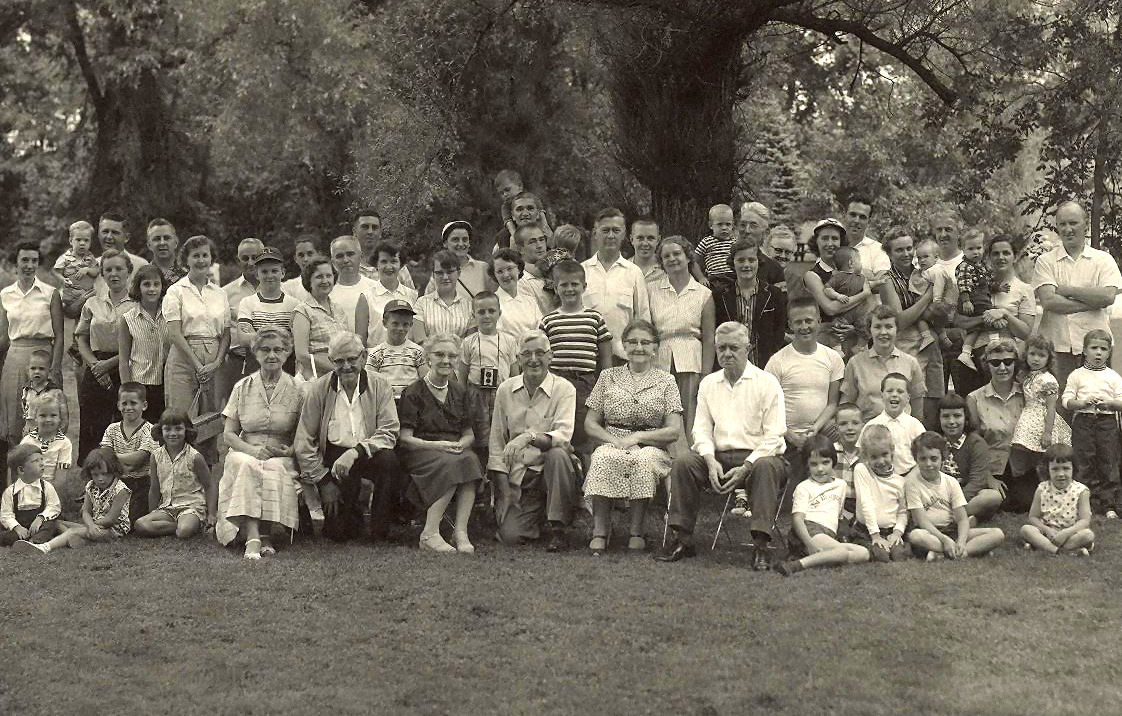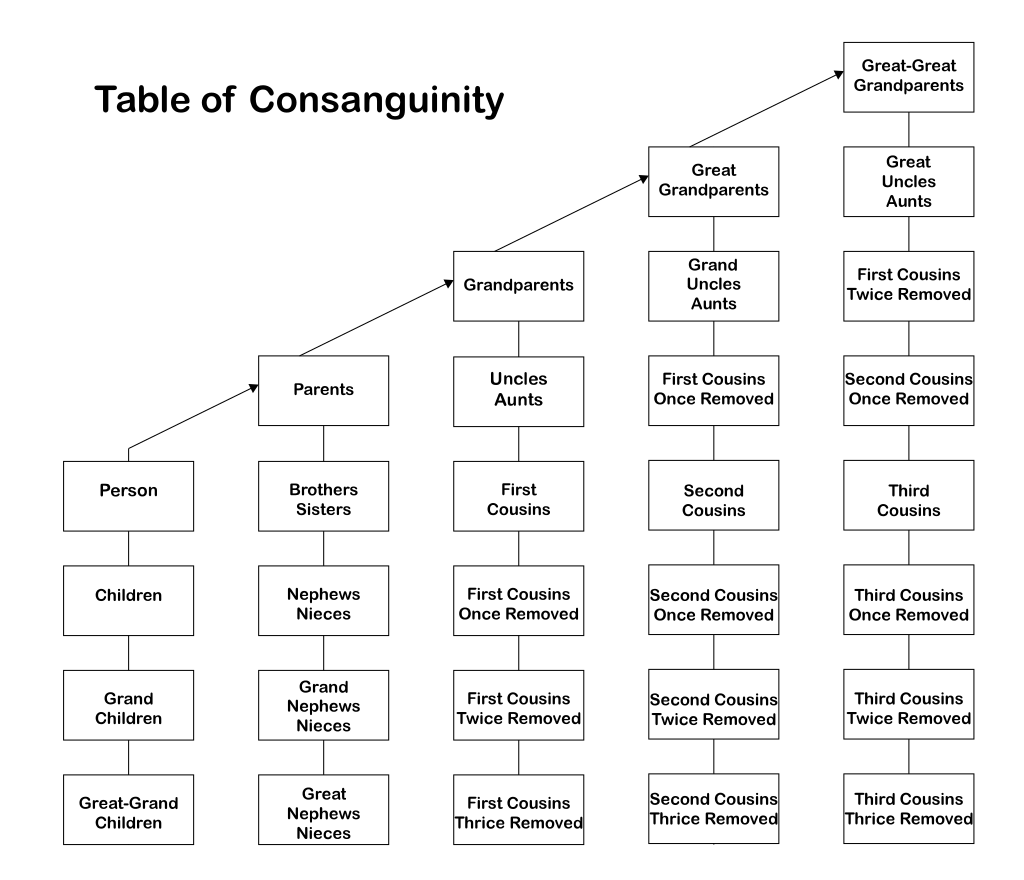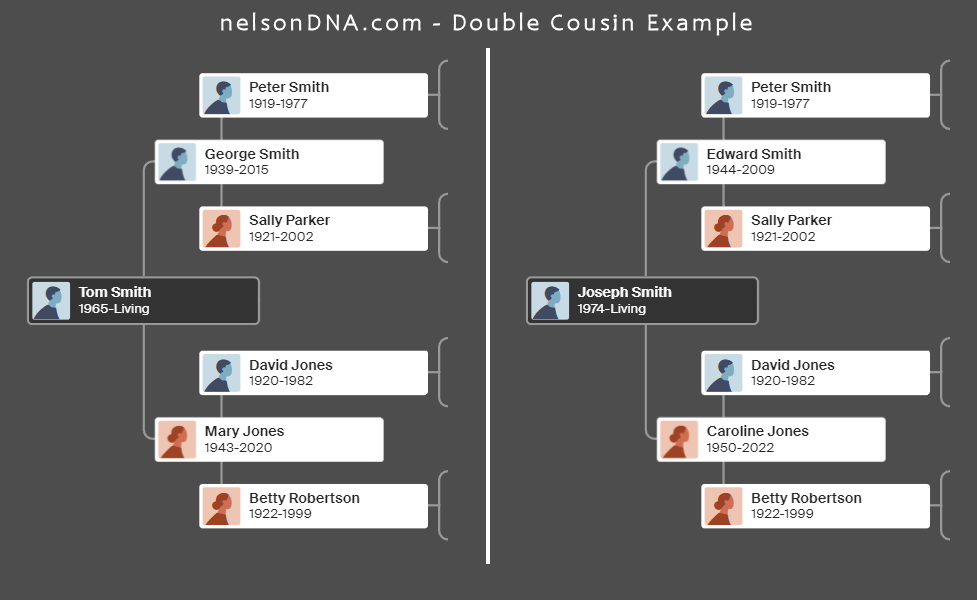UNDERSTANDING FAMILY RELATIONSHIPS
PART 2
 April 4, 2023
April 4, 2023
Before getting into DNA numbers, there's still quite a bit of information to cover on family relationships. An important subject to understand is "generations." The generation you are in greatly effects DNA numbers. For example, earlier we discussed first, second, third cousins, etc. In the previous examples, we assumed the relationships were to people in the same generation as you. Someone who is your first cousin would be in the same generation. They would be your parent's sibling's child. What happens if they are a generation younger or older though?
REMOVED COUSINS
Someone who is the child of your first cousin can't simply be called your "first cousin." Since they are one generation younger than you, they are your first cousin once removed (sometimes abbreviated 1c1x). The same is true if YOU are the person in the younger generation. Therefore, someone who is your parent's first cousin is also your first cousin once removed. This all applies to second, third, fourth, cousins etc. A child of your second cousin is your second cousin once removed (2c1x). A grandchild of your second cousin would be a second cousin twice removed (2c2x). Always remember, each generation apart you are is one "removal."
The chart below will help you determine relationships. Here's how it works... Let's say you wanted to know what relationship your grandfather's brother's son was to you. On the chart, look for "person" on the left side. That's YOU. Now, move up to where it says "grandparents. " Next move over one column to the right. Moving to the right refers to a sibling. So now you're on your grandfather's brother. His child will be one row lower. Each movement up or down the chart is a generation younger or older. So now we are on "first cousin once removed." There's your answer. Your grandfather's brother's son is your first cousin once removed.

Let's try another relationship to make sure you have the hang of it. What do you call your great-grandfather's sister's great-grand daughter? Move up to the great-grandparent level, move over one column to the right. Moving down one row would be her child, two rows would be her grandchild, and three rows would be her great-grandchild. There's your answer, THIRD COUSIN.
GRAND VS. GREAT CONFUSION
Unfortunately, there's a confusing bit of information to deal with here. What do you call your grandfather's sibling? There's two terms which are used interchangeably and it's very confusing. Notice this chart shows the relationship as your GRAND aunt or uncle. I actually photo shopped the chart so it would say that. It originally showed the relationship as GREAT aunt or uncle. There apparently is no standard name for this relationship and it's quite ridiculous. You will find it listed both ways. Since it's in the GRAND generation, why not call it GRAND aunt or uncle to avoid confusion? You would be their GRAND niece or nephew. Luckily, Ancestry.com also prefers the better term, GRAND. Your great-grandfather's sibling would be your GREAT aunt or uncle. Some charts show GREAT-GRAND. Again, that's more confusing.
NOTE: On all future posts, I will refer to a grandparent's siblings as GRAND aunts or uncles. Your great-grandparent's siblings will be GREAT aunts or uncles. It just makes sense!
HALF RELATIONSHIPS
Things would be much easier if siblings all had the same two parents. When working on your family history, you will likely come across many "half relationships." If two siblings have the same father, but a diferent mother (or vice vera), they are HALF SIBLINGS. If you and a cousin have only ONE GRANDPARENT in common, you are HALF COUSINS. If you and a second cousin have only ONE GREAT-GRANDPARENT in common, you are HALF SECOND COUSINS.
Think of it this way. In order to have a FULL relationship with someone, your closest common ancestors have to be a SET, like, husband and wife, or the same two partners. For example, a full first cousin's closest common ancestors to you are your grandmother AND grandfather. Since you have a SET of ancestors in common, you are FULL cousins. If they have a different grandmother or grandfather, your closest common ancestor would be just a SINGLE person. They would be a HALF COUSIN. There's several ways to think about these relationships. Another example would be... Your half cousin is the child of your parent's half sibling. Makes sense, right? If your parent's full sibling's child is your FULL cousin, then your parent's half sibling's child is your HALF cousin. It takes time to really get a grasp of all the relationships. Some people get discouraged and give up, but that's why I'm here to help or do it for you.
DOUBLE COUSINS
There's plenty of unusual relationships out there as well. I've seen this one a few times. I'd call it uncommon, but not super rare. A double cousin relationship happens when two siblings from one family have children with two siblings from another family. The children will have FOUR grandparents in common. The best way to understand is to visualize this in a family tree. I've put together an example in the image below. The two trees show Tom Smith and Joseph Smith's parents and grandparents. Notice, they both have different parents, but they have the same FOUR grandparents. Why? Because their fathers were brothers and their mothers were sisters. You might be wondering, how does this effect the DNA? It effects it greatly. In fact, as you might expect, it pretty much DOUBLES it. Double cousins will have about as much DNA in common as half siblings.

FUN FACT
Did you know it's legal in every US state to marry your second cousin, and legal in about half the US states to marry your first cousin. It is even legal to marry a double cousin in many of those states, which is a little surprising since they share so much DNA.
My next post is an interactive quiz to test your knowledge of relationships.

